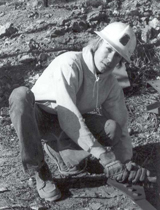In 1872, when early settlers staked their claim to the San Xavier mine 20 miles south of Tucson, they didn't have the luxury of air conditioning or state-of-the-art safety facilities. Back then mining posed great danger and miners had few resources to prevent casualties. The situation continued in a primitive fashion for students who learn to become miners at the San Xavier, until recently. That has mine director Ros Hill crowing with delight as he gives a tour of the Western Mining Safety and Health Training Resource Center.
"We haven’t had a facility this nice for years and through funding from Science Foundation Arizona and Freeport Copper we were able to build this center, which is set up not only as a training center but as a mine rescue practice center," says Hill.
The center contains a training room, kitchen, offices and showers. Recently the UA won a 1.6 million-dollar federal grant to provide training to local students and mine employees from all over the West with the expectation of creating an emergency mine rescue team to dispatch to accidents.
Mining remains one of the most dangerous industries, with a fatality rate six times higher than that in other professions. According to statistics from the Mining Safety and Health Association, 67 people in the U.S. lost their lives in mining accidents in 2007 and more than 7700 suffered non fatal injuries. The largest portion of the fatalities involved people with less than five years experience on the job. With demand growing for mined resources, the potential danger makes the new center even more significant.
Arizona deputy mine inspector John Stanford investigates every mining incident in Arizona. He also directs safety operations, like the one at the new center.
"It's very important for the new miner, for the new manager coming on to understand the dangers of mining and the aspects of that danger and to eliminate those as much as possible out of the mining industry, and to recognize those hazards way before they happen," Stanford says.
On a recent sunny Saturday, Nura Amasri gamely submitted to role playing the victim as fellow students strapped her into a basket and carried out the scenario of a miner injured in a blasting accident. Mining student Bree McMaster played the part of the rescue team foreman.
"It's really good for students to get an introduction to that because in every mining company safety plays a huge role," says McMaster. "At the internship I had last summer there was a safety meeting each week and for any workers going out there was a safety share each morning. So it's really good to give students an introduction that its not a one time unit. It’s going to be something that’s continuous in their field."
The $1.6 million three-year federal grant will provide training for thousands of students and miners who will eventually make up an emergency rescue crew in the Southwest. Hill says the mine rescue team would be used in Southern Arizona on call. Hill has devoted his 40 year career to mining safety after assisting in the Sunshine mine rescue in in Kellogg, Idaho, where 91 miners lost their lives in 1972. His hope is that when they graduate students will have the confidence to put together a rescue team that will succeed as spectacularly as the effort that the world witnessed recently in Chile.
"When they graduate I want to instill in them a safety culture that they will carry with them for the rest of their lives, as well as to any private or public industry they may enter so they have a sense of accomplishment and understand the importance of safety and taking care of their people," Hill says.
 A $1.6 million three-year federal grant will provide training for thousands of miners and mining students who will eventually make up an emergency rescue crew in the Southwest.
A $1.6 million three-year federal grant will provide training for thousands of miners and mining students who will eventually make up an emergency rescue crew in the Southwest.
The San Xavier mine serves as a classroom for students who learn everything about operations, from safety to blasting and drilling. Students see the potential opportunities to travel and supply the critical resources our society demands. Students also serve as mine managers, as co-manager Dana Specht can tell you. Tall and dusted with dirt, she sports a t-shirt with "I heart explosives" on the back, a mining helmet and a heavy belt festooned with mining tolls. She has already spent two mining tours in Australia and expects to begin work at the Resolution mine in Superior after graduation from the UA in 2011. She reflects on the controversial placement of mining operations planned for Arizona, but remains circumspect about the state of our overall economic health.
"if you can’t grow it you have to mine it and it's unfortunate that it’s in our backyard," says Specht. "But there’s nothing wrong with mining and we’re trying to work at the highest standards and going above what is required of us. Miners, we care too about the environment, and we want what is best."
In fact, mining students find a world of opportunity in their own backyard. The new facility definitely inspires those aspirations. Students love it so much that several plan to hold their own wedding receptions at the San Xavier mining safety center.
The UA Department of Mining and Geological Engineering: http://www.mge.arizona.edu/templates/standard/index.php?ID=31
AZ Department of Mines and Mineral Resources: http://www.admmr.state.az.us/
Mine Safety and Health Administration: http://www.msha.gov/

By submitting your comments, you hereby give AZPM the right to post your comments and potentially use them in any other form of media operated by this institution.